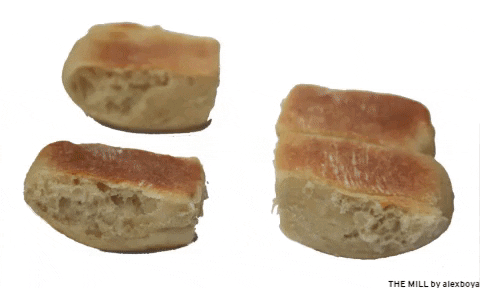Guni-Gunitain: Sorbetes
It’s probably nostalgia that makes me think that cheese ice cream bought from a Mamang Sorbetero on the street tastes better than cheese ice cream purchased from a grocery store.
Guni-Gunitain is "guni-guni" and "gunitain" combined. It’s part imagination, part memory recollection—but always the result of missing where I came from. I miss the Philippines every day, and this is how I cope.
Sorbetes is more often called “dirty” ice cream in Manila—not because it’s not clean, but because it’s sold on the streets by your local Mamang Sorbetero out of a brightly painted wooden cart.
While some sorbetes flavors are relatively easy to find here in the United States, I have yet to see my favorite: cheese. I wasn’t a fan of our local ice candy flavors—red beans, mung beans, etc.—but cheese sorbetes in a pandesal fresh from the local panaderia was an unstoppable combination that made many of my Saturday mornings a lot better. I also liked mantecado as a flavor, but found in my research for this piece that it’s not actually unique to the Philippines! It’s a Cuban thing.
What Makes Sorbetes Different From American Ice Cream?
Originally, sorbetes was made with cow’s milk, much like American ice cream. However, manufacturers in the Philippines began using locally available ingredients such as coconut milk, carabao milk, and even cassava flour to make it more affordable. These substitutions reduced costs and gave sorbetes its unique flavor and texture, setting it apart from the Western ice creams that inspired it.
Apart from cheese (or queso) and mantecado, sorbetes comes in various flavors—such as coconut (or buko), avocado, melon, mango, jackfruit, and even durian. These flavors reflect the abundance of tropical fruits in the Philippines. Distinctly Filipino flavors include ube and toasted rice (or pinipig).
Coconut Milk
My husband always teases me about my dislike for everything coconutty. I don’t enjoy the flavor and texture of coconut in many Filipino food preparations. I don’t like the long strips of coconut meat in fruit salads and coconut juice. I don't like shaved niyog on top of my kakanin, like kutsinta or pitsi-pitsi. I don’t like drinking coconut water, even when I’m sick or dehydrated.
But I do like coconut milk as an ingredient in many dishes, like curries and sorbetes. I’ve even made chicken adobo with coconut milk added to the sauce. Apart from street sorbetes, many brands make ice cream with coconut milk in the Philippines—it’s a great vegan option, and coconuts are literally everywhere.
Carabao Milk
My earliest memory of carabao milk was seeing it on the breakfast table during visits to Pampanga, where my family worked with locals for our tropical fish business. Often, people would pour carabao milk or coffee over their rice. I wasn’t a fan of eating rice that way, and I wasn’t a fan of drinking carabao milk by itself. The milk felt rich and a bit too much to handle, and I also felt “rich and a bit too much to handle” as a young girl from the city drinking a whole glass of milk that would have otherwise been poured onto two or three plates of rice.
But products made from carabao milk are truly top tier. I love kesong puti, a Filipino cottage cheese traditionally packed in little portions with banana leaves. We used to buy it by the dozen at Nepa Q-Mart, our local palengke in Cubao. I also love pastillas. My mother sent a care package to me recently that included two big boxes of pastillas—they sit on the kitchen counter, mocking me. I can’t eat a lot of them now that I’m diabetic, but they’re still so, so good. Apart from street sorbetes, some brands also make ice cream with carabao milk. My favorite is Arce Dairy.
Cassava Flour
What is cassava flour? I didn’t know until doing my research for this piece that it’s actually tapioca flour. I also know cassava by its local name: kamoteng kahoy. I know what cassava cake is—sometimes called a type of bibingka, to confuse people, I guess—so the term “cassava” is not unfamiliar. Honestly, I think I’m more familiar with this root crop than with ube. I’m sure I’ve eaten more food containing kamoteng kahoy than food containing ube. I might get canceled for this, but kamoteng kahoy is the Philippine root crop everyone should be obsessed with.
But this is new territory for me. I also didn’t know that cassava could be used in making sorbetes. Apart from cassava cake, I’m familiar with pitsi-pitsi and minatamis na kamoteng kahoy. Both were consistent summer merienda recipes at my childhood home. My dad loved thin slices of the root crop cooked in brown sugar—sort of like an abridged version of minatamis. During the rainy season, we would make bilo-bilo, which sometimes included cassava.
What’s So Special About Cheese Sorbetes?
I think of cheese sorbetes in pandesal as the opposite of a perfect grilled cheese sandwich. Bread and cheese—how could you go wrong? While a grilled cheese offers you toasted bread and melted cheese, cheese sorbetes in pandesal offers you a crisp crust over soft bread and rich ice cream with pops of flavor from actual bits of cheese. The cheese they use for sorbetes is probably processed, similar to American processed cheese, and tastes like a mild cheddar.
It’s probably nostalgia that makes me think that cheese ice cream bought from a Mamang Sorbetero on the street tastes better than cheese ice cream purchased from a grocery store or even a local ice cream shop in Manila or anywhere else. And it has to be eaten with pandesal—that’s how my Ate Josie introduced it to me, so that’s the perfect way to eat it.
What About Mantecado Sorbetes?
I’d always thought that mantecado ice cream was just butter-flavored. But, it’s more complicated than that! It’s apparently butter with vanilla. I believe the Filipino version of mantecado stops there. The Cuban mantecado adds cinnamon and nutmeg, and instead of messing with the type of milk, they use a whole lot of eggs to make a custard base.
What’s the Next Best Thing to Sorbetes?
There’s no choice here in the U.S. that even comes close. But my personal “next best thing” to sorbetes has been to enjoy Very Berry Strawberry ice cream from Baskin-Robbins. Of course, I had strawberry ice cream in the Philippines. It’s a very common flavor. But I don’t think Filipinos know how to make the strawberry flavor shine in ice cream. I never considered myself a “strawberry girl” until I tasted the Baskin-Robbins version. I think of it as leaning into being in the U.S., versus missing what I can’t have anymore.
What about you? What’s your favorite ice cream flavor?
Photo by Judgefloro on Wikimedia Commons
If you’ve enjoyed reading this or something else I’ve written, please consider buying me a coffee. ☕ Thank you!









I like Jamocha Almond Fudge from Baskin Robbins, but cheese sorbetes on pandesal sounds awesome!